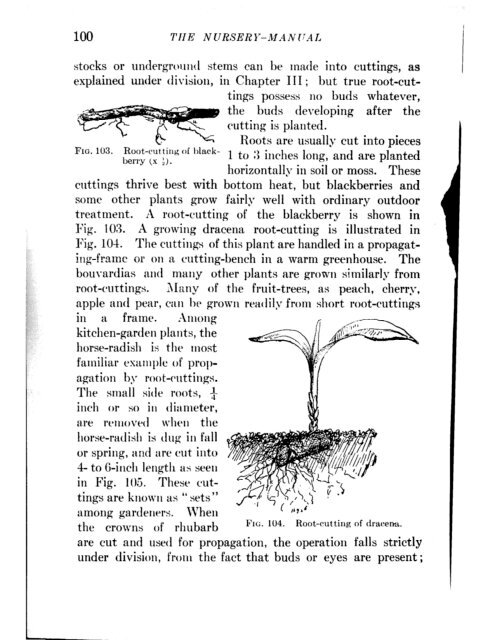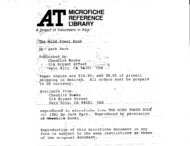- Page 1 and 2:
CHEREFERENCELIBRARYA project of Vol
- Page 4:
THEALBYL. PI. BAILEY
- Page 7 and 8:
.(‘11.4 PTERI. SEEDS ASD SHOOTS .
- Page 9 and 10:
hl iscrlla,ruWls forms of graftingS
- Page 11 and 12:
LISTOF PTAATES1.II I.III.IX.x.xi.x1
- Page 13 and 14:
CHAPTERISEEDS ANDSHOOTSTHE earth is
- Page 15 and 16:
SEEDS AND SHOOTS 3or accident befor
- Page 17 and 18:
Once a matter of home-growing and s
- Page 19 and 20:
SEEDS AXD SHOOTS 7the staple field
- Page 22:
10 THE NURSERY-.MANUi41,and carrot.
- Page 25 and 26:
12 THE NURSERY-MANUALhausted the st
- Page 27:
14 THE NURSERY-MANUALsown on the en
- Page 30 and 31:
PROPAG.4 TION BI’ MEANS OF SEEDS
- Page 32 and 33:
PROPAGATION BY MEANS OF' SEEDS AND
- Page 34 and 35:
PROPAG.4TlON BY MEANS OF SEEDS AND
- Page 36 and 37:
-_- . ..~._ _._67571067575144775515
- Page 38 and 39:
-PROP,4GATIOX BY MEANS OF SEEDS AND
- Page 41 and 42:
28 THE NURSERY-MANUALacross to perm
- Page 43 and 44:
30thermometer (d)ma.y b e placedto
- Page 45 and 46:
32 TH.E NCJRSERY-MANUA I,“ 111 t
- Page 47 and 48:
THENIJRSERY-MANU-4E
- Page 49 and 50:
36 THE NURSERY-MANK4Loperators. Som
- Page 51 and 52:
treated in this way. They are soake
- Page 53:
40 THE NURSERY-MANUALsort of strati
- Page 56 and 57:
PROPAGATION BY MEANS OF SEEDS AND S
- Page 59 and 60:
46 THE NURSERI’--MANUALOver the m
- Page 61:
48‘rrl’l~r rwepta(+5 in ?vltic4
- Page 64 and 65: .. \;_ -: ..
- Page 66 and 67: 52 THE NURSERY-MANUALCross-section
- Page 68 and 69: 54 THE NURSERY-MANUALtrough. By var
- Page 70 and 71: CIIAI’TEI~IIIPROPAGATION BY MFANS
- Page 72 and 73: 58 THE N URSERY-nil,4 N UA I,leek,
- Page 74 and 75: 60 THE h’ ITRSEIZ 1’- MA N ilA4
- Page 76 and 77: 5;62 THE NURSERY-MANUALfollowing se
- Page 78 and 79: and represents but ;I single node ;
- Page 80 and 81: 66 THE NURSERY-MANUALas well as her
- Page 82 and 83: 68 THE NURSERY-MANlJALstock species
- Page 84 and 85: ’I(i. ,-)!b. Ru~~rwr of srclgc, c
- Page 86 and 87: 72 THE NURSERY-MANUALcase the cover
- Page 88 and 89: 74 ‘l’rrl!: NUIZSEIZY-k?~4N Q/A
- Page 90 and 91: 76 ‘r[II!: N (iR$ER Ii’--MA N i
- Page 93 and 94: cliIws liids of air-hycrh g, varyin
- Page 95: PLATE III. Prupngntion of hydrangea
- Page 98 and 99: PROP.-1GATIOiV BY MEANS OF CUTTINGS
- Page 100 and 101: .r.-,- ,+:,-- ‘- tic=e-.5c._-.
- Page 102 and 103: PXOP.-1GA TIOA;’ LiY MEANS OF CUT
- Page 104 and 105: PROl’,4Cr’A TlO,V BY MEANS OF C
- Page 107 and 108: 92 I’IIE NURSERY-MANUALquic~l+-.
- Page 109 and 110: 94 THE NURSER Y-MAN UA Iiparent bra
- Page 111 and 112: grape cuttings are sometimes pa&ed
- Page 113: ‘rlll)clrs arc tilidwtlcd pilrtS
- Page 117: twgonias, also, tlw hole leaf may b
- Page 120: in moss, said or sawdust in a cella
- Page 123 and 124: 108 THE NURSERY-MANUAL1. -In making
- Page 125 and 126: i10 THE NURSERY-MANUALmonths. If bo
- Page 127: ll’t THE NIJRHERY-MANtJALThe read
- Page 130 and 131: 114 THE IVURSERY-MANUALwould not at
- Page 132 and 133: 116 TIIE NURSERY-MA NiJALing of unc
- Page 134 and 135: I118 THE NURSERY-MA.NUALing, or gra
- Page 136 and 137: 111 the sw,mii of greatest growth i
- Page 138 and 139: the operation is tlwr-. tedious and
- Page 140 and 141: 124 7’HE .V URSEIt I'-ilILt N (!.
- Page 142 and 143: 126 THE NURSERY-M,4NUALsmooth and e
- Page 144 and 145: 12s ‘I’HE N17RSERF-MANUALThe il
- Page 146 and 147: 130 THE NURSERY-MANUALoff just abov
- Page 148 and 149: sowing. In peaches, the bud will pr
- Page 150 and 151: 134It would not profit us to pause
- Page 152 and 153: 136 THE NURXERY-MANUALextends only
- Page 154: 138 Tflh’ NUiiS;ERY-i!lAN UALl’
- Page 158 and 159: 144 THE NURSERY-MANUALend of the ci
- Page 160 and 161: 146 THE NLrRSERY-MANUALlished. Some
- Page 162 and 163: 148 THE NURSERY-MANUAI,dressil,g, h
- Page 164 and 165:
1 I, n . I... _ L _.arc c!lett-~raf
- Page 166 and 167:
152 THE NURSER Y-MAN I/ALtree is th
- Page 168 and 169:
154 THE N ~~RSERI’--MAA’~‘UAL
- Page 170 and 171:
150 THE NURSERY-MANliALthe new tiss
- Page 172 and 173:
C.35 I.cz-7’rt- - cccE
- Page 174 and 175:
1 tie '1'111i A\' I 'K,SEK1'-X.4 N
- Page 176 and 177:
162 THE NURSERY-MANUAL.“The ragge
- Page 178 and 179:
l&&‘I’HE NURSERY-MANUALand more
- Page 180 and 181:
with waxed muslin or i’w#ia, and
- Page 182:
purpose of growing n variety 011 an
- Page 185 and 186:
PROPAGATION BY BUDDING AND GRAFTING
- Page 187 and 188:
PLATE VI. A nursery of ornamental s
- Page 189 and 190:
174 THE NCTR,SERY-MANUALloamy on to
- Page 191 and 192:
176 THE NURSERY-M-ANUALl~usba&~~, t
- Page 193 and 194:
178 THE NURSERY-MANUALQ~S~~II~~N no
- Page 195 and 196:
180 THE NURSERY-MANUALA first-class
- Page 197 and 198:
152 THE NURSERY MANIJALPeach, 1 yea
- Page 199 and 200:
IS4 THE NURSERY-,MANITALPersimmon i
- Page 201 and 202:
18t.i THE NliRSERY-MANUALOne never
- Page 204 and 205:
CERTAIX ELEikIENTS IN NURSERY PRACT
- Page 206 and 207:
fall prematurely, thus retarding th
- Page 209 and 210:
.194 THE NURSERY-MANK4ipunctures th
- Page 211 and 212:
196 THE NURSERY-MANUALga.11 infecti
- Page 213 and 214:
198 7’IlE NURSERY-MANTJA I,certai
- Page 215:
200 TllE NIJRSERY-MANIJAL&ITIRACNOS
- Page 218 and 219:
.-ihoulrl bc ma(lc soon after tllc
- Page 221:
CERTAIN ELEMENTS IN NURSERY PRACTIC
- Page 224:
The spots are first small, but tliP
- Page 227 and 228:
CERTAIN ELEMENTS IN NURSERY PRACTIC
- Page 229 and 230:
~ERT,i IN El,E~IfENTR IN N IJRSERY
- Page 231:
CERTAtIN ELEilIE,VTS IN NURSERY PRA
- Page 234:
220 THE NURSERY-MANUAL(‘ones shou
- Page 238 and 239:
TftE N URSh’fZ Y-LIST 223t, I )eg
- Page 241:
226 THE iVURi?ERY--MANUALalk to alm
- Page 245:
Androsace. I’riw rr~crct~~.I’rc
- Page 249 and 250:
234 THE I\r/TR,SER~‘--Pi~iyi!ALAn
- Page 251 and 252:
236 l’(fE iVURI~EIZE’-:a~r117\1
- Page 253 and 254:
235 TjlE NURSERY-MA.NUALwood cuttin
- Page 255 and 256:
240 7’1113 MIrRS~:IZY-~~i.ilNUBLA
- Page 257 and 258:
242 T’IIE N CRSERY-MAiVUAL
- Page 260 and 261:
--7”+-..C ------I5 =.C.,y zff ‘
- Page 263 and 264:
143 TIlE Ai URSERY-iilANIi.+~Lmatte
- Page 267 and 268:
250 THE NURSERY-MANUALDerivatives o
- Page 269:
Billbergia. B l-0 111 diCWCP.As see
- Page 272 and 273:
7’11 I!: N l~R,SER I-‘--l,l,sI
- Page 274 and 275:
THE NURSERI--LIST 257properly packe
- Page 276:
259Briza (Quaking Grass). G’ra~nz
- Page 279 and 280:
exercised in preparing t htt pot fo
- Page 281 and 282:
264 THE NURSERY-MANUALcactus an(l e
- Page 283 and 284:
266 TllE NURSMRY-MANUALCalendula (P
- Page 285 and 286:
268 THE NURSERY- hlil N IT,4 K,spcc
- Page 287 and 288:
270 THE NURSERY-RIANK4Lstock is pro
- Page 289 and 290:
372 THE NURSERY-MAN/JAI,Ceanothus.
- Page 291 and 292:
274 7’TT‘E NURSERY-MANlJ,t I,Ce
- Page 293 and 294:
276 THE NURRER~‘-111,4NUAI,must,
- Page 295 and 296:
~alualde in thr Nnrthwtlst, whcrc g
- Page 297 and 298:
way. The union is imperfect in many
- Page 299 and 300:
THE N lJR,SERY--LIST 381in &-inch p
- Page 301 and 302:
THE NIJRSERY-LI,ST 283Cladrastis (Y
- Page 303 and 304:
THE NURSERY-LIST 285Clytostoma. B i
- Page 305 and 306:
‘I’ll 15 iV Cl RSI< R Y-LIST 28
- Page 307 and 308:
THE NURSERY-LIST 289Corn-Salad ( Vd
- Page 309 and 310:
TIIIE NI?KSERY-LIST 291cuttings 2 o
- Page 311 and 312:
TN?: NURSERY-LIST 293Crocus. I ridr
- Page 313 and 314:
TIIE NURSERY-LIST 295off when the c
- Page 315 and 316:
ITHE NURLYERY-LIST 207mass-effect,
- Page 317 and 318:
THE N URSEZW--LIST 299t;tken as cut
- Page 319 and 320:
THE NURSERY-LIST 301Dicksonia. Cyat
- Page 321 and 322:
THE i’WRSERI’-LIST 303Dodecathe
- Page 323 and 324:
THE NURSERY-LIST 305Echinopsis. Cac
- Page 325 and 326:
THE NURSERY-LIST 307Epiphyllum. Cnc
- Page 327 and 328:
Erythronium (l)og’s-toot11 Violet
- Page 329 and 330:
THE NURSERY-LIST 311Exacum. C(>rl t
- Page 331 and 332:
?‘lIIIl NIJIZ,Sl~IL)l~---f~1,S7
- Page 333 and 334:
THENURSERY-LIST315Fortunella : Ii
- Page 335 and 336:
THE NI.iRSERZ’-LIST 317hyat of ab
- Page 337 and 338:
Gillenia. Rosnceca.Propagated readi
- Page 339 and 340:
TlIE NCJRSERY-I.&ST 321.Godetia. O~
- Page 341 and 342:
THE NURSERY-LIST 323In vineyards, l
- Page 343 and 344:
THE NURSERl‘-LIST 325root-grafts
- Page 345 and 346:
TiIE NURSERY-LIST 327whole operatio
- Page 347 and 348:
THE XURSERI’--LIST 329Gunnera. ii
- Page 349 and 350:
Hedysarum. lqu IO iwstr.I’r(jp;lg
- Page 351 and 352:
PLATE X. E'irst-class dwarf apple s
- Page 353 and 354:
Hieracium (Hawk-Keed). Corrzyosit~.
- Page 355 and 356:
loom. These cut,tings are slips (pa
- Page 357 and 358:
338 ‘1’111;: N URSER Y-MA N I/A
- Page 359 and 360:
348 THE NURSERY-MANUALIsoloma. Kohl
- Page 361 and 362:
Juncus (R.ush, Rulrush). J 11,ll cn
- Page 363 and 364:
344 THE NURSERY-MANUALKoelreuteria.
- Page 365 and 366:
factory if sown in tlw fall. - _ Se
- Page 367 and 368:
348 THE NURSERY-MANUALfor a home su
- Page 369 and 370:
350 THE NURSERY-M,4NUAI,Lime (Citru
- Page 371 and 372:
35% 7’111; N LTRSE’Rl’-MA N 7
- Page 373 and 374:
Lygodium (Hartforcl Fern. Climbing
- Page 375 and 376:
3 c 33 7’IfE NURSERY-MAiVUALMalva
- Page 377 and 378:
I ricwased by srAs, sown either und
- Page 379 and 380:
360 THE NURSERY-MdhTUALMertensia (L
- Page 381 and 382:
362 THE iVURt.!3ERY-dilAiVUALMonste
- Page 383 and 384:
364 THE NURSERY-MANUALmushroom-grow
- Page 385 and 386:
366 7’IIF: N IJRSER IT-ML4 1V UA
- Page 387 and 388:
,SCW~S should not 1~8 livpt too lon
- Page 389 and 390:
370 THE NUlLSER Y-MA It’ U A l-1s
- Page 391 and 392:
372 THE NZ/'RSERY-2C~AN1?,4Ltagc of
- Page 393 and 394:
374 THE NVRSERY-.16,4 iVTi.4 I,ling
- Page 395 and 396:
376 THE NURSERY-MANUALOrnithogalum
- Page 397 and 398:
stvds are imported 112’ the dtial
- Page 399 and 400:
Parsnip ( I’cisfiilmw srrfim), I~
- Page 401 and 402:
382 THE NITRSERY--MANIJ~4 Lthey may
- Page 403 and 404:
384 THE NURSERY-MAN7JALdiffcult to
- Page 405 and 406:
%I5 THE NURSERY-ilfANUi4LperFormed
- Page 407 and 408:
THE iWJfiYWRY--LIST 387Pell*a ((I7l
- Page 409 and 410:
THE NURSERY-LISi! 389is responsible
- Page 411 and 412:
THE NURSERY-LIST 391Phzdranthus. Il
- Page 413 and 414:
THE NURSERY-LILST 393P. nii:oszr.s
- Page 415 and 416:
‘I’ZIE N IJRSERY-1,187 395i :.1
- Page 417 and 418:
.THE NURSERY-LIST 397used for the f
- Page 419 and 420:
Tl1E N CJRSERI’--LIST 399the\ spr
- Page 421 and 422:
THE NURSERY-LIST 401Plumeria. *4pOf
- Page 423 and 424:
THE *iVURSERY--LIST 403slioultl pl*
- Page 425 and 426:
THE NlJRSERY-LIST 405Pterostyrax. S
- Page 427 and 428:
THE NunSER~‘-LIST 407the greater
- Page 429 and 430:
THE NURSERY-LAST 409Retinospora, sp
- Page 431 and 432:
hut, it is not.. hardy t7lol~gll fo
- Page 433 and 434:
THE NURSERY-LIST 413stocks are grow
- Page 435 and 436:
THE NURSERY-LIST 415Sagittaria (;2r
- Page 437 and 438:
THE NURSERY-LIST 417Satyrium. Orch.
- Page 439 and 440:
THE NURSERY-LIST 419S. Emnzelia??n
- Page 441 and 442:
THE NURSERY-LIST 421Solanum. Soharr
- Page 443 and 444:
.=:w
- Page 445 and 446:
424 THE NURSERY-MANUALStenotaphrum
- Page 447 and 448:
426 THE Nr!RSER~-n-l.aIvrJALStrelit
- Page 449 and 450:
425 THE NURSERY-MANUALemployed. Lil
- Page 451 and 452:
430 THE NURSERKikiANUALThea (Tea).
- Page 453 and 454:
432 THE NURSER1’-MANUALTomato ( L
- Page 455 and 456:
--434 THE NURSERY-MANUALTurnip (Bra
- Page 457 and 458:
4X TIIE NlJRSERY-MANUALferht long)
- Page 459 and 460:
438 THE N7,rRSERY-nlA~UALintlcpcncl
- Page 461 and 462:
440 THE NURSERY-MANUALXanthosoma. A
- Page 463 and 464:
INDEXTht> rr~111:1r c,:ll,tic,rl-c~
- Page 465 and 466:
Brazilian Rubber-Tree, 332Bread-Fru
- Page 467 and 468:
INDEX 447I):~jTc~ciii; riri5D:Gsy,
- Page 469 and 470:
1RrDEX 449Heel cutting, 94Hecling-i
- Page 471 and 472:
INDEX 451.tMilk Vet&, 245Milkweed,
- Page 473 and 474:
Prirkly ,Isih, 441); Pear. 370Pride
- Page 475 and 476:
455Spirlacia okracea. 423Fj,innc~h.




